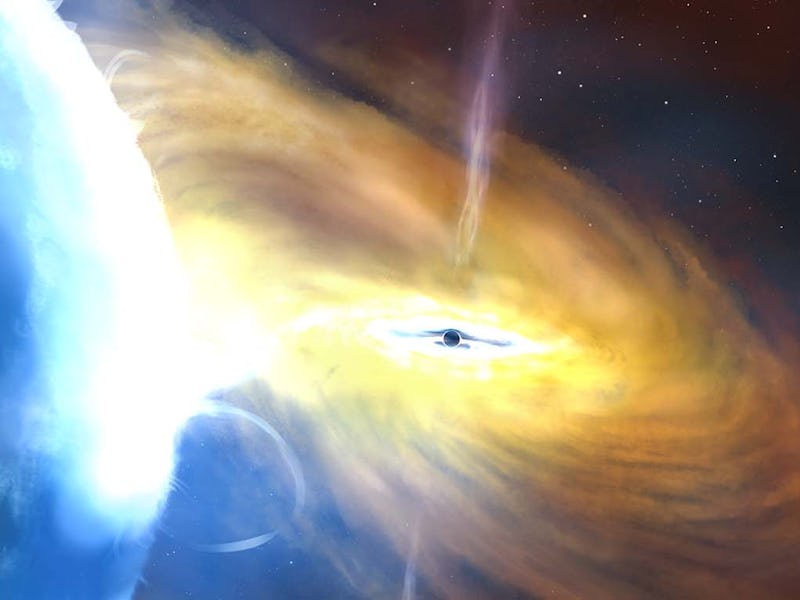Astronomers Discover the Dark Source of the Brightest Cosmic Blast Ever
AT2021lwx is outlasting and outshining supernovas by a big margin.

The science of black holes can often pay massive dividends. On Friday, for instance, two universities announced that their researchers have analyzed “the brightest cosmic explosion ever seen” around one ancient behemoth.
The data required to find events like this is hard-won. First, an astronomer must direct instruments to peer into the deep Universe, using light’s finite speed to search for superbright events of the past. Study author Michael Fulton at Queen’s University Belfast tells Inverse that what their team found was a single blast “100 times brighter than all the stars in the Milky Way combined.”
In the case of the new announcements from the University of Southampton and Queen’s University Belfast, the record-making event took place about 8 billion years ago. At that time, the Universe was less than half its current age. “You could probably say it is shortly after ‘Cosmic Noon’ ... just past the peak of star formation, so a more active time in the life of the Universe compared to the present day,” Fulton says.
To find this glimmering pearl awash in the sea of the night sky, astrophysicists needed a tool that was collecting pixels of the cosmos by the trillions.
It was the Asteroid Terrestrial-impact Last Alert System (ATLAS), based in Hawaii, which surveys the entire night sky several times a day. Its computers are able to pull out interesting anomalies where light is appearing or shifting in unexpected ways. Finding bright explosions like this was possible thanks to this front line of processing, which narrows down scientific prospects.
The demise of AT2021lwx as captured by various observatories.
When ATLAS looked toward the constellation Vulpecula (the Fox), it may have picked up on one of the most epic blasts ever recorded. “Astronomers reveal the largest cosmic explosion ever seen,” officials from both UK universities announced on Friday.
The blast may come from a ravenous supermassive black hole feasting on a buffet of gas and dust possibly thousands of times larger than the Sun. As the behemoth “violently disrupted” the large “doughnut” shaped cloud, it sent shockwaves through the remnants, officials from the universities write. This resulted in an intense luminosity.
According to their news statements, a collection of telescopes witnessed an event “more than ten times brighter than any known supernova.” Known as AT2021lwx, it’s been visible for more than three years, far outlasting the typical months-long duration of a supernova flash.
Meals of a supermassive black hole
“The accretion of matter on to supermassive black holes is the most efficient known process of extracting energy in the Universe,” write the authors of the April 2023 study that describes AT2021lwx’s luminosity. The paper is published in Monthly Notices of the Royal Astronomical Society.
Supermassive black holes at the center of galaxies have different sorts of meals. If they have a continuous conveyor belt of material to gobble, the gas churning around them can cause the center of the galaxy to glow incredibly bright. These are called active galactic nuclei.
But there are also events like AT2021lwx, which more closely resembles a singular and sizable meal, called a tidal disruption event. The study authors call this “a much shorter, yet far more violent accretion episode.” Both university statements say that AT2021lwx outshines the next-biggest tidal disruption event by triple the brightness.
“We are still trying to figure out why this particular black hole started feeding so vigorously and suddenly ... Today, AT2021lwx is ten times fainter than it was at its brightest point, but this small fade is insignificant compared to how bright AT2021lwx was and still is. In three years, this event has released 100 times as much energy as the Sun will in its entire lifetime,” Fulton says.
An illustration of a black hole.
A marker of the past, and the present
AT2021lwx happened when the Universe was 6 billion years old. At this point in time, supermassive black holes were already past their prime, Boston University astrophysics professor Alan Marscher (who was not involved with the new work) tells Inverse. But if AT2021lwx is any indication, these black holes were still voracious.
ATLAS’ analysis of AT2021lwx was complemented by data from other observatories. The Zwicky Transient Facility in California, for instance, was the first to notice the blast. An international contribution from ground-based observatories and the Neil Gehrels Swift Telescope in space helped the team to round out the investigation, write Queen’s University Belfast officials.
And with all that, we learn about the cosmos at its mightiest. And we begin to weave a tale about the Universe’s history.
“So, from several billion years to the present time, supermassive black holes haven't grown so much,” Marscher says.
“Many, though, continued to have episodes of activity and to have an effect on the galaxies that contain them, but that should have been stronger at earlier times,” he adds. Supermassive black holes may have interacted with the gas in between a galaxy’s stars as they fed, affecting the galaxy’s evolution.
But this peek into the ancient Universe is impossible without computer learning to narrow down trillions of pixels into a sample size. “The sort of all-sky monitoring and analysis in real-time that we’re doing was basically unthinkable 40 years ago. And 20 years ago, the technology really didn’t exist. What we’re doing is we’re sort of living on the bleeding edge of technology,” John Tonry, ATLAS principal investigator (who was not involved in the new work), tells Inverse.
Tonry says the future of this technology could create a sort of “genome sequencing” of the Universe.
This article was originally published on